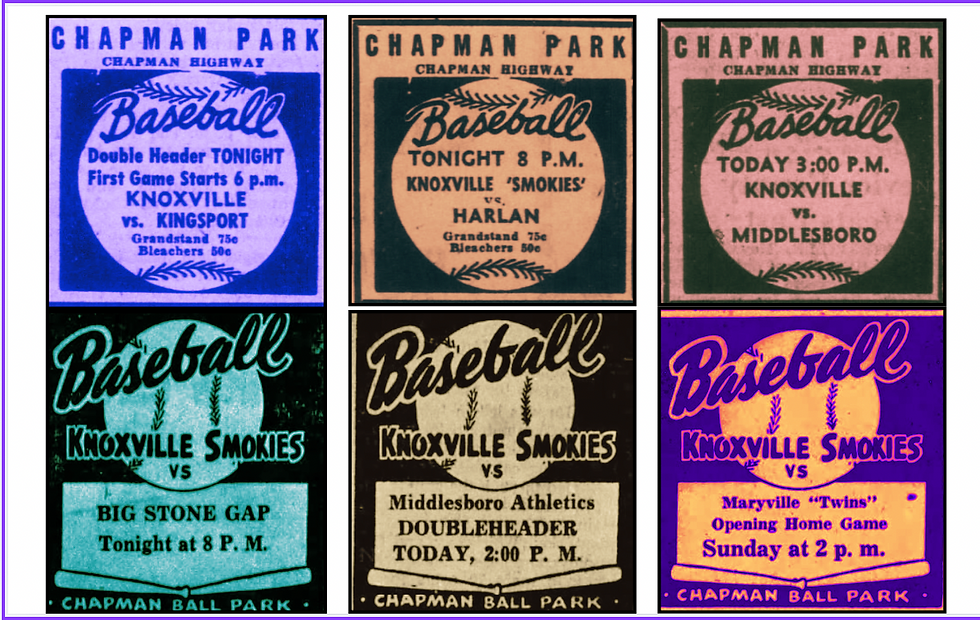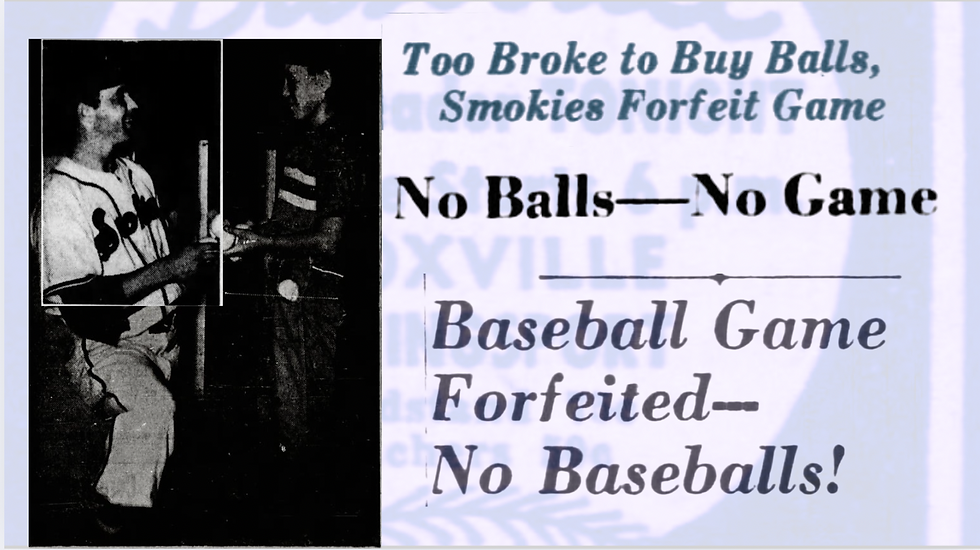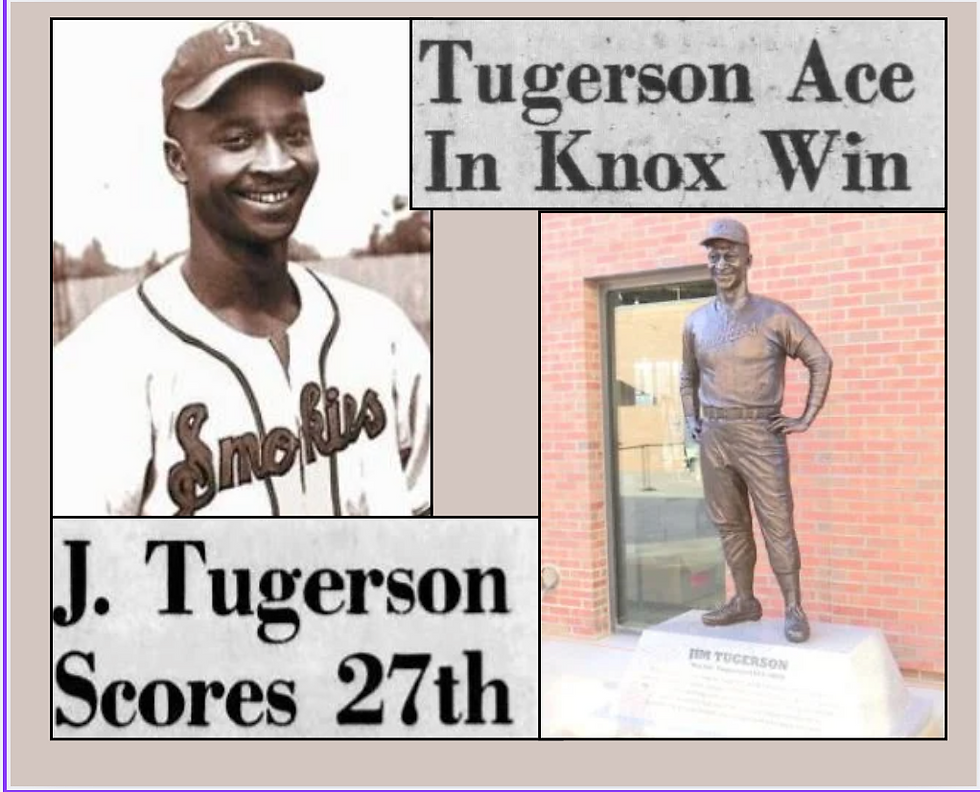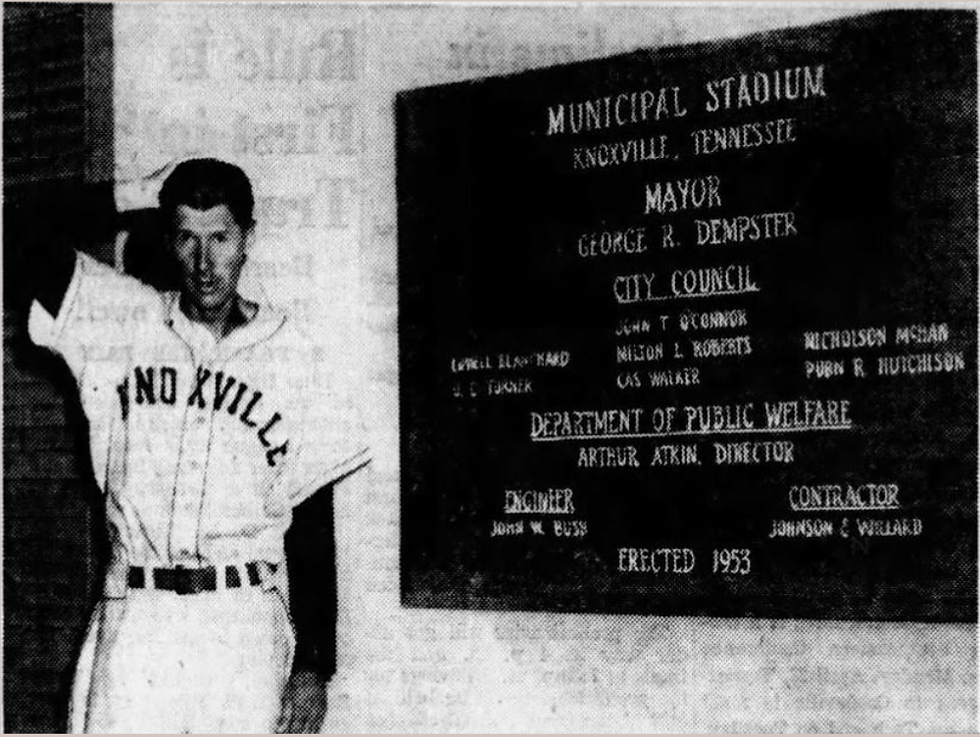Knoxville Smokies Interesting Year of Baseball
- Marc Viquez

- Sep 23
- 7 min read

Today, the Knoxville Smokies proudly stand as a beacon of community spirit in their stunning new $114 million ballpark, right in the heart of downtown. This moment marks not just a return, but a homecoming filled with excitement and renewed hope after nearly 25 years spent away in distant Sevier County.
Knoxville has its beloved franchise back where it belongs—ensuring the city’s vibrant baseball tradition will thrive for generations. Yet, this triumphant homecoming was once far from certain.
Baseball had been played at Smithson Stadium since the wooden structure was erected in 1931. The Smokies had been members of the Class B Tri-State League since 1944, but city officials wanted a higher-class team in their city. To attract investors of a Class A or AA team, a new stadium would need to be constructed. A civic vote favored 2-1 in favor of a new structure on the same site as “Smitty.”
This trend continued for a couple of seasons. By the 1952 season, the Smokies and the Tri-State League were struggling with low attendance, franchise instability, and considerable uncertainty from one day to the next. Team owner Carl Lyerly, who was battling with Dr. Hobart Ford, who owned the lease to the stadium, sold the franchise to the New York Giants in June and rid himself of losing any more money out of his pockets.
The Giants were committed to staying in town, but first relocated their Class B franchise to Danville, Virginia. The Giants were concerned about the future of the Tri-State League, which was teetering on existence at the time. The league was debating whether to fold the Greenville Spinners and the Smokies to become a 6-team league.
It now seemed like the perfect time to start building that new stadium that the folks of Knoxville voted for a few years ago. The aging Smithson Stadium was on its last legs, and now seemed like the ideal time to start construction to lure another club in time for the following season. Sure, the 1953 season would be a wash, but a modern plant with steel and concrete would be an investment for baseball for years to come for its citizens.

The 1953 Smokies played home games at Chapman Highway Ballpark
Not so fast. There was a contingency that did not want baseball to go dark in 1953. Once it was announced that the Tri-State League would welcome back the Greenville ball club, former Smokies business manager Jack Aragon led a group of investors to purchase the team. He suggested postponing construction until after the season in September.
“We certainly hope to keep baseball in Knoxville,” said Aragon. “It will be a long summer, maybe two or three summers if baseball is lost here at this time.”
It led to a question of “Build Now” or “Build Later” with many sports columnists sharing their thoughts. Many were in favor of allowing the Smokies another season, while others wanted to rid the city of the Class B team in favor of a higher classification, regardless of whether it meant being with pro ball that summer. Knoxville News-Sentinel sports columnist Tim Skiler wrote the following.
“A new stadium would quickly solve two problems-it would bring new owners-solid, responsible citizens-ready and eager to invest in baseball, and a chance at possibly higher baseball. Certainly, a city with a new park, plus a metropolitan area of $330,000, would not go begging for organized baseball. A new stadium would bring big league stars. They now detour Knoxville.”
Starting construction as soon as possible would give workers 14 months to handle any unforeseen delays and also save close to $25,000 working in the warmer months compared to winter months. There was added concern that the conflict in Korea might prohibit the purchase of steel and other products if construction were postponed.

The city council begins razing Smithson Stadium in the spring of 1953.
Finally, on January 27, the City Council voted to raze the Smithson grandstand and start construction on the new ballpark. Aragaon, who was holding a franchise, soon quit his position with the club to take over the family-owned gas station. It wouldn’t last long, as he then accepted a similar position with the nearby Maryville-Alcoa Twins of the Mountain States League. As far as anyone was concerned, there would be no baseball in Knoxville that year.
Things went quiet until March 9, when Virgil Q. Wack of the Mountain States League announced they would operate a Knoxville franchise at Chapman Highway Park that season. The announcement was protested by the Maryville-Alcoa club, whose ballpark was only 8.2 miles away from the new Knox franchise. There was also concern that the Mountain States League owned the territorial rights and approved any new franchise to begin play at the new stadium in 1954. However, the new owners would exit and not interfere with any territorial squabbles for a future franchise.
“No Knoxvillian could possibly happy about being in the Class D MSL, the lowest in organized baseball, but if we are going to continue to boast about American enterprise, hustle, imagination and courage then it will behooves us to condemn Wacks for putting something legal over on local capital, brains and political influence,” wrote sports columnist Tom Anderson in the Knoxville Journal on April 12, 1953. “It begins to look as if he slid in here safely while we were looking at the sky for a spaceship bringing us an SL franchise.”
Mayor George Dempster objected to the new club adopting the Knoxville name and even sought an injunction to prevent its use. In response, the Knoxville Journal sports staff mockingly dubbed the team the “Chapman Park Seviers,” noting their Sevier County home field, and reserved the “Smokies” label only for when they lost. The season peaked with an opening-day crowd of 3,000, a turnout that would prove to be the lone highlight of the year.

By late May, the team plunged into debt, accumulating $21,000. This amount would need to be paid off for any future ownership group willing to operate in town for the next five years. But the greatest humiliation came on May 28, when the team was forced to forfeit a game simply because they had run out of baseballs.
It might have been the first and only time that a professional baseball team at any level forfeited a game in this way, and the episode made national headlines. The next day, local kids from the neighborhood came out to the ballpark to return and donate baseballs that were taken home from previous games.
The club announced that it was moving operations to Hazard, whether temporarily or permanently. Ben Byrd of The Knoxville Journal wrote the following in his column on May 29.
“Knoxville had nothing to do with bringing Mountain States League ball here. Its officials, its fans, and this newspaper opposed it from scratch. In their brief but still overlong stay, they have brought the city no prestige, no entertainment, no commerce, no nothing. If Chapman Park stands empty and deserted these summer nights, it won’t be much different from when the Smokies were playing there.”
As miraculous as it was to not have enough baseballs for a game, the ball club was saved by Dr. Edward L. Grubb. He operated the club and stadium on a 50-50 basis, wound up erasing its debt, and became the owner of the territory rights in town. This meant that he would be the person to talk to when putting a team in the new stadium under construction. The team would still wear the Smokies name on its uniforms, but the one local paper referred to them as the Knoxville ball club.

Jim Tugerson dominated the Mountain States League in 1953 with a 29-11 record and 286 strikeouts.
One bright spot was a pitcher, Jim Tugerson, who at age 30 was playing his first year of professional baseball. He integrated the Smokies after being barred from playing in the Cotton States League. “Big Jim” went on to win 29 games and four more playoff games, guiding the Smokies to the league championship.
They rejoined the Tri-State League for the 1954 season and opened the season in front of 6,154 people at Municipal Stadium. The attendance figure was the largest at the time to see a game in town. Unfortunately, the loop was once again in turmoil, and Knoxville was dropped due to travel concerns. The TSL became a four-team organization and ceased operations after the 1955 campaign.
With no league to enter, the lease on Municipal Stadium expired in April due to Grubb not fulfilling the terms of the contract, thus opening up the territory to any new ownership willing to bring a team into town. That would occur 14 months later when a group of businessmen led by future city mayor John Ducan transferred the Montgomery Rebels of the South Atlantic League to town.

Pat McGlothin gets ready for the first game at Municipal Stadium in 1954
The renamed Smokies played its first home game in front of 7,100 people on June 20, 1956, marking a triumphant return to affiliated baseball. The city finally achieved its goal of obtaining a high-level baseball team and became a Double-A team in 1963, and joined the Southern League the next year. The following year, the stadium would be renamed Bill Meyer Stadium after the former major league baseball manager and serve as home to the club until 1999.
The Smokies have come full circle with the opening of Covenant Health Park this year. A total of 295,000 flocked to the new baseball plant to check out the team that was now playing back in town after 25 seasons in Sevier County. Knoxvillians always were big supporters of the game, but at the highest levels of the minor league ladder. The foreseeable future is bright in “The Marble City”.
At the time, the 1953 Smokies team was not wanted. The prospect of a Class D league jeopardizing any future endeavors was frowned upon by many politicians, sports writers, and fans. However, that team has left a legacy in Knoxville. When you are at Covenant Health Park, make sure you visit the Jim Tugerson statue on the outside concourse.

The Smokies brand new ballpark returned the team to town after 25 years, Photo by Stadium Journey.
———
Follow all of Marc’s stadium journeys on Twitter @ballparkhunter and his YouTube channel. Email at Marc.Viquez@stadiumjourney.com







Comments